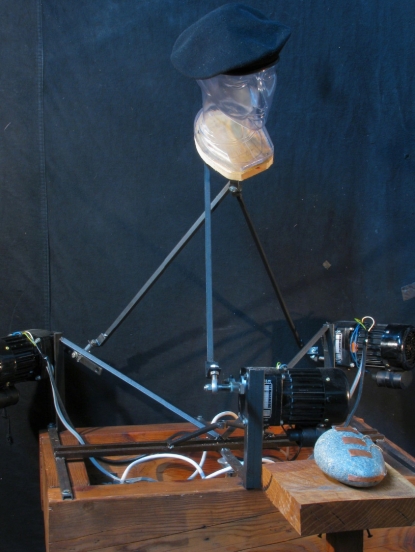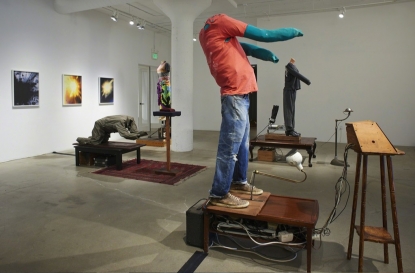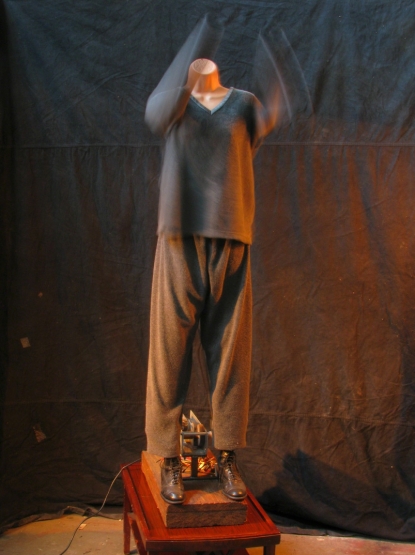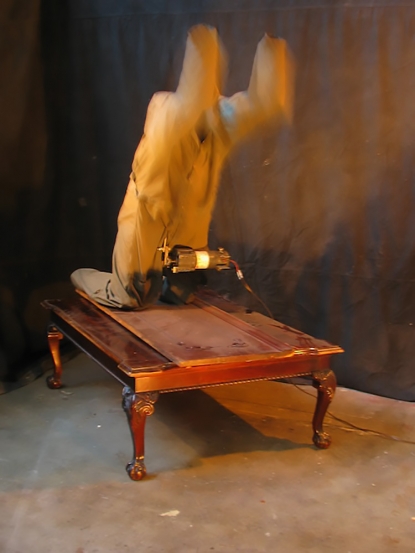
Mark Pauline (2014-2015), Kal Spelletich, Robot, clothes, timer, electronics, wood, coffee table, steel
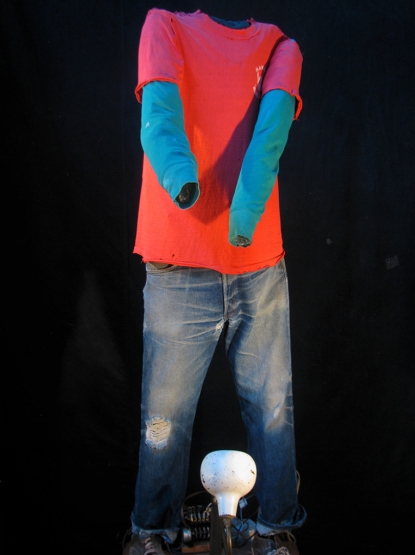
Chris Johanson (2014-2015), Kal Spelletich, Robot, clothes, timer, electronics, wood, coffee table, steel
Feature: Conversations
A talk with Kal Spelletich
Editors note: Bay Area artist, founder of the influential artist group SEEMEN and participant in SRL activities Kal Spelletich spoke with Chris Cobb about how and why spirituality (and sincerity) has come more to the fore in his work, his background in punk rock, and the changes in the contemporary art scene, and much more on the occasion of his first exhibition entitled Intention Machines at the Catherine Clark Gallery. The exhibition looks at the question of spirituality coupled with technology and whether one can inform the other.
In another interview between Chris and Kal, the idea of “selling out”, Kal’s fascination with and the influence of Marcel Duchamp on his work and contemporary art, and his invitation to work with defense contractors was published in SFAQ online: http://sfaq.us/2015/05/kal-spelletich-in-conversation-with-chris-cobb/An upcoming review by Stretcher contributor Theo Auer of Intention Machines will also explore the role of spirituality and technology in the work of Kal Spelletich.
Kal was last seen in the Bay Area in Art in Motion, the inaugural exhibition of the Jules Maeght Gallery in Hayes Valley.–Amy Berk
Chris Cobb: Let’s get right to the point - why did you make an entire exhibit about praying robots?
Kal Spelletich: Well, things are so messed up in the world. If praying might help, why not try?
CC: O.k. ...
KS: Also, I am a news junkie, so I follow the daily news regularly... and as the years go by, my amazement and disgust about the world just grows and it all just frustrates me. Will this planet ever solve its problems? Maybe praying robots can help? They sure can’t hurt.
CC: I guess you are just following the scientific method – try something, test it… see if it works…
KS: There are just so many challenges these days - economic disparity, endless war, the war on black lives, environmental destruction, the war on women, the prison industrial complex, lack of compassion in society, legal injustice, bigotry, drone/spy society, the corporatocracy running/ruining the planet and it just goes on and on.
CC: And you think robots might be able to help?
KS: I see art as life support for the planet. It’s a way to tackle the relationship between religion and belief, technology and science. And, in the meantime, have some fun.
CC: Does it concern you at all – that praying robots might be taken sarcastically, as if you were making fun of religion? Like a snarky critique of religion or something?
KS: About 12 years ago I started to become more interested in being sincere. Back then, NOT being cynical, NOT being snarky or satirical - that seemed radical. So at that point in my life I decided it was lazy and immature to be those things. I’ve learned that sincerity disarms people, and our society needs it more than ever.
CC: I always think about how some future archaeologist out there might look back at what people are making now and wonder why we made it. Maybe they would see robots as a way we made copies of ourselves in order to perform tasks we can’t do, or can’t bring ourselves to do?
KS: Exactly. It’s all connected. So I asked myself - Can a robot do spiritual work? Many cultures buried representations of themselves to do work in the afterlife for them. There was also this belief that these statues or figures would come alive for them. So with all of these sorts of questions in mind, I have been developing and hacking biometric sensors - the same tech as EKG’s AND EEG’s - the sensors that make consciousness manifest physically, which, by itself is incredibly amazing if you think about it.
CC: That is definitely a wide open territory for making art.
KS: Right! - to transform reality with your mind or to build thinking machines. One of my goals is to figure out how to combine art and mysticism with science and technology, maybe even try to get robots to convey emotions?
CC: Seeing your work, it’s tempting for people to just assume what you do is mostly influenced by Survival Research Labs and Burning Man, but you were doing this stuff long before your associations with either of those organizations. What comes to my mind when I see your work isn’t art so much, but music – I am thinking of industrial bands like Einstürzende Neubauten, or Bauhaus. I am thinking of Orchestral Manuevers in the Dark (OMD), Kraftwerk and punk rock bands. All those bands playing in garages in the 80’s, just trying everything out.
KS: I did actually help book punk bands wherever we could in Iowa during the early 1980's. Later on in Austin too – in the mid/late 1980’s. There is definitely a thick thread that runs from E.N., S.R.L., D.I.Y. (any other acronym’s?) to punk.
CC: So organizing shows and doing art stuff was all kind of swirling together for you then?
KS: Yeah, all of that was when I was around 19 years old, so yeah, but I was more into bands like Hüsker Dü (from Saint Paul, Minnesota), but again, it was all connected.
CC: That makes sense. I think a lot of artists each have their own personal soundtrack and when in doubt, they make their own. It’s the music they turn to for inspiration, for work, for loving…
KS: Music changed everything for me as a kid…it was so liberating, and continues to be so. It was a mainstream field where something radical could happen while at the same time I watched my parents and their friends leading boring, mainstream lives.
CC: I’d imagine Iowa was pretty square.
KS: Yeah, it was the one thing I was bound and determined NOT to do/be. I think music is what helped me get interested in art and the mystical aspects of art, from Leonardo to Duchamp. Piero Manzoni, Yves Klein, James Lee Byers, Joseph Beuys, Alice Coltrane, Alice Aycock, Louise Bourgeois, Wolfgang Laib, Patti Smith, David Hammons to the Dharma Bums/beats, hippies, Yippies, Diggers, Dharma Punks. There is always something mystical/spiritual about art if you look hard enough, if you want to see it.
CC: And yet now you’re kind of like alluding to spirituality but without growing the beard or wearing the costume?
KS: I think artists are always seekers. They are the ones looking for something that is out there, but that lies unseen. That idea has been around for a long time.
CC: In that same sense do you feel your robot art is not just spiritual but also political… or do you separate your politics from your work?
KS: It is political. I don’t think there is a separation in this day in age. The work critiques our love of technology and honors it at the same time. It jabs at consumerism and sleek products. I am interested in messing around with techniques, messing with our presupposed ideas of what a robot should do for us and how it should respond. Confounding expectations.
CC: In the past decade or so art venues and the way artists show work has really transformed. The art market has expanded but people seem more paranoid than ever. Your work seems to be changing too. For example, you are showing now more with galleries than in the past. Or am I totally wrong?
KS: Good observation. You are right, as the venues and opportunities change I changed the work. The U.S. has changed. I realized if I wanted to show I had to adapt. That was really hard for me. I have had to completely change the way I show/present the work like four times in my career. There used to be so many great underground venues. After 9/11 my world changed as the police and fire departments got more uptight. The venues all changed too as real estate became the last thing the U.S. decided to gin up the price for. I still think about that a lot. Last year I exhibited in Cologne Germany, in an old school type squat, I was so excited about working with pyrotechnics again! And in such a radical space.
CC: What did you think when the NY Times called you “a pioneer of San Francisco’s machine-art scene?”
KS: Humbled, yet it is so sad I am the last guy in SF still making stuff from that scene. It was such an incredible era. But it has been a marathon, not a sprint.
CC: I admire your optimism and your engagement with robots is uncommon. I think nowadays most people making robots are not so altruistic.
KS: Yeah, we are screwed, maybe hackers can take care of them? The Boston Dynamic’s robot dogs will be chasing us down the streets in the next decade, I guarantee it. And they will be armed to the teeth.
CC: So you think that’s the whimper humanity will end with, like in Terminator?
KS: Well, who knows? I really believe that humans are wily and crafty and brilliant. We can improvise. I think we will rise up over our overlords, whoever they might be, but it will be long and messy. Maybe it will resemble the way in which most artists these days have to operate outside the system just to survive.

